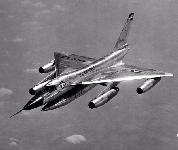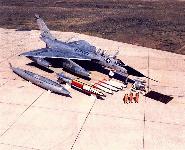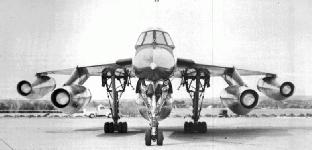







The general operating requirement, SAB-51, called for the replacement of the B-47 to be the first supersonic bomber. Research and development studies began in the late 1940's, and both Boeing and Convair developed conceptual designs. In 1952, the more revolutionary Convair design was chosen and designated the B-58, with the first flight occurring November 11, 1956.59 The program was not a competitive development, and Convair was given total development responsibility. As a result of money and schedule problems, the number of aircraft produced was reduced from 244 to 116, with its initial deployment in 1960.
The B-58 represented a drastic change from the B-47 in design, acquisition strategy, and deployment philosophy with SAB-51 being the first time that Air Force requirements called for radical, technological advances. The design specifications called for a Mach 2, high-altitude, medium-range nuclear bomber of minimum size to keep a low RCS. Convair was the prime contractor under the "Weapon System Management Concept" introduced with the B-58 and had responsibility for all subcontractor performance. This was in marked contrast to prior programs in which the Air Force was responsible for providing the prime contractor with "off-the-shelf" technology subsystems. The deployment concept was also different from the B-47 since the B-58 was designed to rely on quality rather than quantity. These radical changes in the Air Force's approach to bomber development resulted in many problems.
For example, meeting the technological requirements proved difficult and resulted in schedule slippages and cost overruns, while under-funding and lack of space on board affected development options. Subsequently, the B-58 was considered an interim bomber since the XB-70 was on the drawing boards. The B-58 had a delta wing design that included many firsts for strategic bombers. It had four turbojet engines with afterburners, and was the first supersonic aircraft with engine pods mounted outboard on the wings. The wings had a span of 56 feet, 10 inches and were swept 60; the length was 96 feet, 9 inches; the height at the tail was 29 feet, 11 inches; and the maximum takeoff gross weight was 160,000 pounds. The crew consisted of a pilot, navigator, and defensive systems operator seated in tandem. While a retrofit provided each crew member an individual ejection capsule for supersonic bailout, the cramped crew cockpit made long missions like airborne alert very exhausting for the crew.
The high altitude range of 3,500 nm for the B-58A and 4,000 nm for the B-58B included the use of a large centerline fuel pod. Although this range was better than the B-47, the lack of forward basing resulted in a requirement for more tanker support. While the B-58 was faster than Soviet fighters, the newly emerging threat was the development of SAMs in the late 1950's that forced the B-58 to adapt to low level penetration of enemy defenses. This change in mission profile caused a large increase in fuel consumption and compounded range problem.
The B-58 did not have a bomb bay but could carry one nuclear weapon externally with the centerline fuel pod fitting over it. Four weapons, whether nuclear or conventional, could be carried on external hard points if the fuel pod was eliminated, thus degrading the aircraft's range further. With fewer aircraft deployed, a larger payload was needed to deliver as many weapons as its predecessor, the B-47. But the amount of space available for modifications was less than that for the B-47. In an era of improving SAM technology, ECM modifications have been continually needed to meet the evolving threat, and space was not available for additional ECM.
The B-58, although the holder of numerous world speed records, was severely restricted in its usefulness and lifetime. Designed for supersonic, high-altitude penetration, the B-58 was limited in range, payload, and growth potential for the addition of advanced radar and other electronic equipment.
Thus, replacements were the main mode of modification. For example, analog electronic equipment with cooling problems was replaced by digital electronics. The B-58's planned production run was reduced because of the high cost per unit, a small payload, a mission profile different from its design concept, and, in the 1960's, a Secretary of Defense that downplayed the role of the bomber. In addition, it was very expensive to operate, and huge sums of money were needed for the Vietnam war.
The first B-58 was delivered in August 1960 and by 1964 deployment had reached about 90 aircraft. The B-58 had a Mach 2 dash capability and employed an external weapons pod. The last B-58 was retired in January 1970, about three months after the first FB-111 was accepted by SAC. Although the aircrews swore by the B-58, money and mission limitations led to it being phased out of the inventory after only 10 years of service.
Specifications |
|



